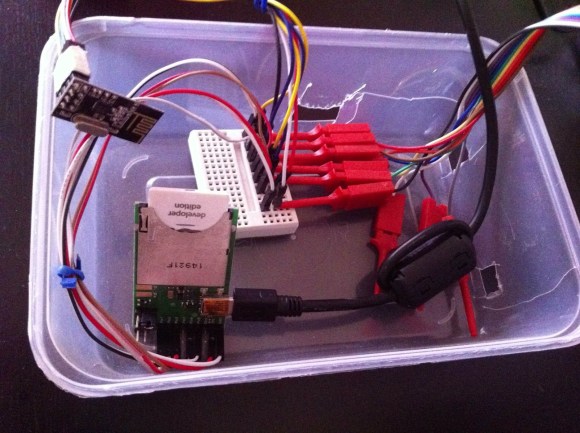
This project is a study in connecting several different families of hobby electronic hardware. The image above shows the Electric Imp side of things. It bridges its Internet connection with the RF connections of the rest of the project.
The Imp is a peculiar (intriguing?) piece of hardware. Take a look at [Brian Benchoff’s] hand’s on experience with the SD form factor hardware which is not an SD card at all. It’s an embedded system which uses light programming and a cloud-based software setup to bring wireless Internet to your projects.
In this case [Stanley Seow] started wondering if he needed multiple Imps to connect different parts of his setup. A bit of head scratching led him to the use of nRF24L01 modules which are cheap and easy to use Radio Frequency transceiver boards. He took a partially finished driver project and brought it home to play nicely with the Imp. Now he can use the system to communicate with other components which will eventually be used for home automation. Right now his proof of concept issues wireless commands to an Arduino driving a strip of LEDs.















In the lights of the recent events this seems like a really bad idea.
The imp relies on data located on remote servers and most of the controll-functions are relayed through those servers, too. And considering you didn’t live in a hole the last month you know how insecure traffic to and data on servers is. With this device you essentially hand control over your home appliances to whoever breaks into the imps servers. Since the whole project is closed-source you don’t know if there are any backdoors or holes in it which might open the way for unauthorised acces. As long as you’re just flashing a few LEDs this doesn’t matter, but once you let it handle security-tasks (like unlock your doors) this is really bad.
Agreed. Security / Hacking issues aside, I wouldn’t want to rely on the uptime of someone else’s (or my own!) server to handle things like getting me into or keeping other people out of my home, etc!
Wonderful. Saves me from re-inventing the wheel this weekend (had actually planned something very similar), and the nRF driver serves as a wonderful reference into the world of Squirrel.
OT; I had not noticed the file extension for a piece of Squirrel code was “.nut”. Ahaa.
So do they have the rights to your code?
Can they prevent uploads of “forbidden” code?
Paranoid, yes, but the possibilities are there.
No, electric imp don’t have rights to your code (well, we have the right to compile it in order to make the service work, but you own your code). There are obviously terms of use – like, you shouldn’t use the service to do illegal things (DoS, spam, etc) – but that seems rather reasonable, doesn’t it? We also do not log or mine any data that flows through the service.
This is all noted in the terms of use & privacy policy, see privacy & terms links at the bottom of http://www.electricimp.com.
If you want to run your own server, nobody is stopping you using an alternate product… this is just a lot easier.
Mike, do you know if Stanley is (or has) updating this to work with the new Imp IDE? This seems very powerful but cant work with the new IDE changes. Thank you.
https://github.com/stanleyseow/electricimp-nRF24L01
Let me update it soon…